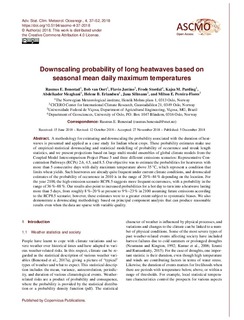Downscaling probability of long heatwaves based on seasonal mean daily maximum temperatures
Benestad, Rasmus; Oort, Bob van; Justino, Flavio; Stordal, Frode; Parding, Kajsa; Mezghani, Abdelkader; Erlandsen, Helene B.; Sillmann, Jana; Pereira-Flores, Milton E
Peer reviewed, Journal article
Published version
Permanent lenke
http://hdl.handle.net/11250/2600164Utgivelsesdato
2018Metadata
Vis full innførselSamlinger
- Journal articles [478]
Originalversjon
Advances in Statistical Climatology, Meteorology and Oceanography (ASCMO). 2018, 4 37-52. 10.5194/ascmo-4-37-2018Sammendrag
A methodology for estimating and downscaling the probability associated with the duration of heatwaves is presented and applied as a case study for Indian wheat crops. These probability estimates make use of empirical-statistical downscaling and statistical modelling of probability of occurrence and streak length statistics, and we present projections based on large multi-model ensembles of global climate models from the Coupled Model Intercomparison Project Phase 5 and three different emissions scenarios: Representative Concentration Pathways (RCPs) 2.6, 4.5, and 8.5. Our objective was to estimate the probabilities for heatwaves with more than 5 consecutive days with daily maximum temperature above 35 ∘C, which represent a condition that limits wheat yields. Such heatwaves are already quite frequent under current climate conditions, and downscaled estimates of the probability of occurrence in 2010 is in the range of 20 %–84 % depending on the location. For the year 2100, the high-emission scenario RCP8.5 suggests more frequent occurrences, with a probability in the range of 36 %–88 %. Our results also point to increased probabilities for a hot day to turn into a heatwave lasting more than 5 days, from roughly 8 %–20 % at present to 9 %–23 % in 2100 assuming future emissions according to the RCP8.5 scenario; however, these estimates were to a greater extent subject to systematic biases. We also demonstrate a downscaling methodology based on principal component analysis that can produce reasonable results even when the data are sparse with variable quality.
